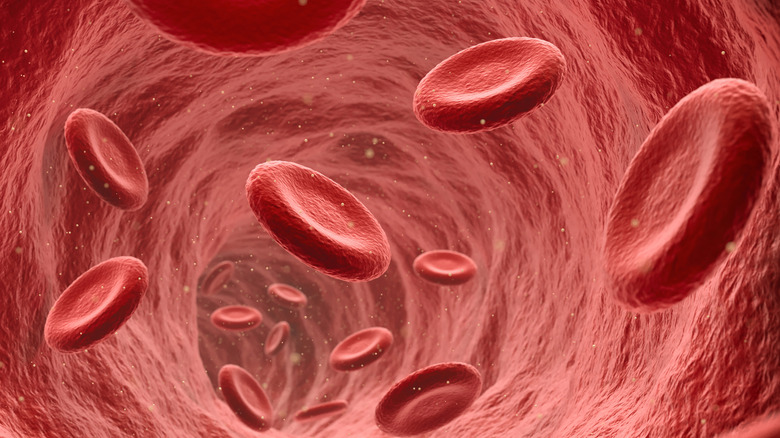Can Human Blood Ever Turn Blue?
Whether it's a cut, scrape, or wound, we bleed blood that appears bright red in color the moment we suffer skin damage. As you've probably noticed on your arms and legs, you can see veins running underneath the skin's surface that may have more of a purple, green, or bluish tint to them. What's the reason for this stark difference and does it mean that our blood can potentially change color?
Standing at 100.4 degrees Fahrenheit, human blood plays a role in body temperature, metabolism, and the transportation of oxygen, hormones, waste, and nutrients. When it comes to color, the thought of blue blood coursing through our body may sound a little bizarre. However, this is the case for certain creatures, including horseshoe crabs and octopuses, according to the Cleveland Clinic. For humans, though, not so much.
"If you get a cut, red is the only color you're going to see come out," hematologist Dr. Alan Lichtin told the Cleveland Clinic. If blood looks red outside of the body, but looks blue underneath our skin, is it possible that our blood changes color while inside the body?
Blood is never blue
Contrary to what we see, experts emphasize that blood is — and always remains — red. Residing within our red blood cells is hemoglobin, which is made up of an iron-containing protein known as heme. It's hemoglobin that carries oxygen where it needs to go within the body. When heme is exposed to oxygen, the result is red blood.
The more oxygen-rich our blood is, the brighter it is in color. As oxygen is delivered throughout the body, however, the oxygen levels of our blood drop, making it a darker shade of red — this is what makes our veins appear blue. That being said, doesn't this mean all of our veins should appear dark red instead of blue? As it turns out, there's another element at play that makes our veins look blue to the eye: light. In essence, light plays a trick on our eyes by altering how it's filtered through our skin and veins. As a result, what is actually red looks as if it's blue.
Can blood change into any other colors?
Although human blood does not turn blue, it is possible for our blood to change from red to a different color. According to the Cleveland Clinic, those with a rare health condition known as sulfhemoglobinemia may experience a temporary change in their blood color from red to dark green. Often related to certain medications, this occurs when the chemical reaction that takes place within the hemoglobin is altered by sulfur compounds. For these patients, blood usually returns to its natural color with the production of new red blood cells.
Alternatively, the Creekside Center for Women explains that blood discharged from the body during one's period can also change color throughout the menstrual cycle. Factors that influence this change in color can include hormone levels, how long blood has remained in the uterus, or even possible infection. Colors that one may observe during their menstrual cycle include black, brown, or various shades of red. Gray period blood may be a sign of infection. Additionally, menstrual blood that has mixed with cervical fluid can appear pink or even orange in color.
All in all, while human blood can turn different colors under specific circumstances, we now know that blue is not one of them.



